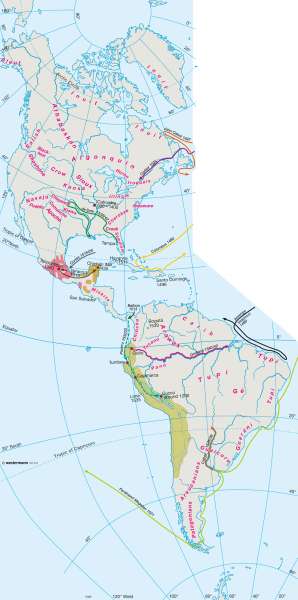Original inhabitants in the 16th century
The Americas - States and history
978-3-14-100790-9 | Page 124 | Ill. 1

Information
At the beginning of the 16th Century, there were a large number of Indian peoples who lived on the American continent, between the ice edge and equator, under various climatic conditions. Among them were three Native American civilisations of the Aztecs, Maya and Incas, in large numbers of nomadic or settled tribes. Some of these tribes, which populated the continent, were hunter-gatherers, and others warlike or agricultural.North America
The Inuit (people) significantly polar Eskimos are Mongolians, who had colonised Alaska, the Canadian Arctic coast and Greenland. In hunting tribes, they lived in skin tents in summer and in igloos during winter, surviving on reindeer, marine mammals and fish.
The Algonquin tribes, including Delawares and Mohicans, settled between the coast and the Great Lakes. In the middle of the 17th Century, the warlike Iroquois ruled south of the Great Lakes and destroyed most of the neighbouring Huron tribe.
The Muskhogees (also known as the Creeks) lived mainly in organised agricultural villages (mound structures), in the southeast of North America.
Very different life forms appeared in western North America. Besides the nomadic hunting tribes and sedentary peoples involved in agriculture, there were the Pueblo Indians who built famous cliff settlements and lived in piled housing constructions.
Central and South America
Central America was dominated by the Mayans and Aztecs. The largest of the Indian empire was that of the Incas. It extended over the greater part of Ecuador, Peru and Bolivia as well as areas of Argentina and Chile. In South America, besides the giant empire of the Incas, there were a variety of Indian cultures with more than 500 languages. In part, there were early forms of an intensive labour, conducted agriculture and some very simple subsistence economies. Many tribes lived here, partly nomadic, partly settled because of the available fishing and hunting, such as the tribes of the Caribs and Tupi-which were largely exterminated by the Portuguese.
European explorers and conquerors
The discoverers of America - Columbus, Vespucci and Cabot (father and son) - were Italian sailors. They tended to follow the coasts and were en route on behalf of Spain or Portugal. The real conquerors of America were the conquistadors such as Cortés and Pizarro, who forcibly subdued the rich civilisations of Central and South America.
K. Lückemeier; Ü: Colette Fleming




